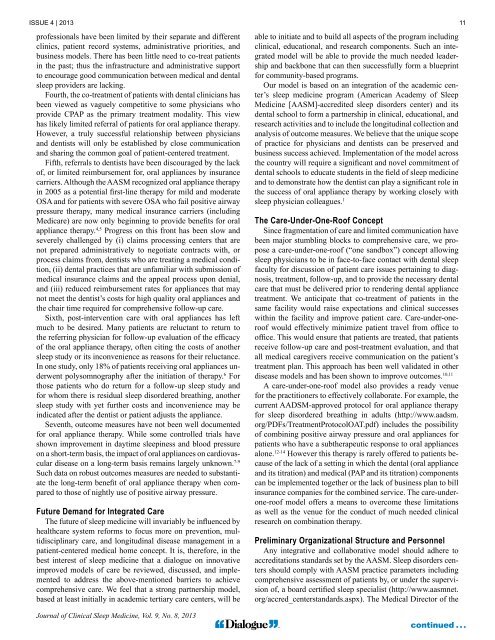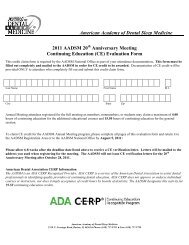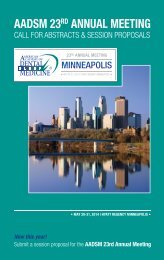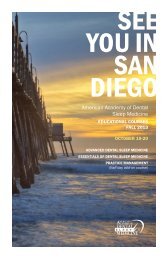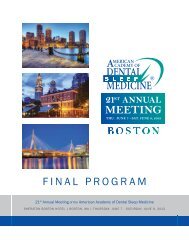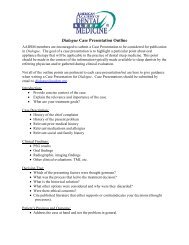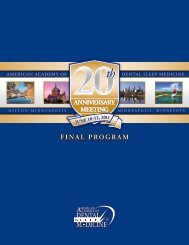In this issue - The American Academy of Dental Sleep Medicine
In this issue - The American Academy of Dental Sleep Medicine
In this issue - The American Academy of Dental Sleep Medicine
Create successful ePaper yourself
Turn your PDF publications into a flip-book with our unique Google optimized e-Paper software.
ISSUE S Sharma, 4 | 2013 G Essick, D Schwartz et al<br />
11<br />
pr<strong>of</strong>essionals have been limited by their separate and different<br />
clinics, patient record systems, administrative priorities, and<br />
business models. <strong>The</strong>re has been little need to co-treat patients<br />
in the past; thus the infrastructure and administrative support<br />
to encourage good communication between medical and dental<br />
sleep providers are lacking.<br />
Fourth, the co-treatment <strong>of</strong> patients with dental clinicians has<br />
been viewed as vaguely competitive to some physicians who<br />
provide CPAP as the primary treatment modality. This view<br />
has likely limited referral <strong>of</strong> patients for oral appliance therapy.<br />
However, a truly successful relationship between physicians<br />
and dentists will only be established by close communication<br />
and sharing the common goal <strong>of</strong> patient-centered treatment.<br />
Fifth, referrals to dentists have been discouraged by the lack<br />
<strong>of</strong>, or limited reimbursement for, oral appliances by insurance<br />
carriers. Although the AASM recognized oral appliance therapy<br />
in 2005 as a potential first-line therapy for mild and moderate<br />
OSA and for patients with severe OSA who fail positive airway<br />
pressure therapy, many medical insurance carriers (including<br />
Medicare) are now only beginning to provide benefits for oral<br />
appliance therapy. 4,5 Progress on <strong>this</strong> front has been slow and<br />
severely challenged by (i) claims processing centers that are<br />
not prepared administratively to negotiate contracts with, or<br />
process claims from, dentists who are treating a medical condition,<br />
(ii) dental practices that are unfamiliar with submission <strong>of</strong><br />
medical insurance claims and the appeal process upon denial,<br />
and (iii) reduced reimbursement rates for appliances that may<br />
not meet the dentist’s costs for high quality oral appliances and<br />
the chair time required for comprehensive follow-up care.<br />
Sixth, post-intervention care with oral appliances has left<br />
much to be desired. Many patients are reluctant to return to<br />
the referring physician for follow-up evaluation <strong>of</strong> the efficacy<br />
<strong>of</strong> the oral appliance therapy, <strong>of</strong>ten citing the costs <strong>of</strong> another<br />
sleep study or its inconvenience as reasons for their reluctance.<br />
<strong>In</strong> one study, only 18% <strong>of</strong> patients receiving oral appliances underwent<br />
polysomnography after the initiation <strong>of</strong> therapy. 6 For<br />
those patients who do return for a follow-up sleep study and<br />
for whom there is residual sleep disordered breathing, another<br />
sleep study with yet further costs and inconvenience may be<br />
indicated after the dentist or patient adjusts the appliance.<br />
Seventh, outcome measures have not been well documented<br />
for oral appliance therapy. While some controlled trials have<br />
shown improvement in daytime sleepiness and blood pressure<br />
on a short-term basis, the impact <strong>of</strong> oral appliances on cardiovascular<br />
disease on a long-term basis remains largely unknown. 7-9<br />
Such data on robust outcomes measures are needed to substantiate<br />
the long-term benefit <strong>of</strong> oral appliance therapy when compared<br />
to those <strong>of</strong> nightly use <strong>of</strong> positive airway pressure.<br />
Future Demand for <strong>In</strong>tegrated Care<br />
<strong>The</strong> future <strong>of</strong> sleep medicine will invariably be influenced by<br />
healthcare system reforms to focus more on prevention, multidisciplinary<br />
care, and longitudinal disease management in a<br />
patient-centered medical home concept. It is, therefore, in the<br />
best interest <strong>of</strong> sleep medicine that a dialogue on innovative<br />
improved models <strong>of</strong> care be reviewed, discussed, and implemented<br />
to address the above-mentioned barriers to achieve<br />
comprehensive care. We feel that a strong partnership model,<br />
based at least initially in academic tertiary care centers, will be<br />
able to initiate and to build all aspects <strong>of</strong> the program including<br />
clinical, educational, and research components. Such an integrated<br />
model will be able to provide the much needed leadership<br />
and backbone that can then successfully form a blueprint<br />
for community-based programs.<br />
Our model is based on an integration <strong>of</strong> the academic center’s<br />
sleep medicine program (<strong>American</strong> <strong>Academy</strong> <strong>of</strong> <strong>Sleep</strong><br />
<strong>Medicine</strong> [AASM]-accredited sleep disorders center) and its<br />
dental school to form a partnership in clinical, educational, and<br />
research activities and to include the longitudinal collection and<br />
analysis <strong>of</strong> outcome measures. We believe that the unique scope<br />
<strong>of</strong> practice for physicians and dentists can be preserved and<br />
business success achieved. Implementation <strong>of</strong> the model across<br />
the country will require a significant and novel commitment <strong>of</strong><br />
dental schools to educate students in the field <strong>of</strong> sleep medicine<br />
and to demonstrate how the dentist can play a significant role in<br />
the success <strong>of</strong> oral appliance therapy by working closely with<br />
sleep physician colleagues. 1<br />
<strong>The</strong> Care-Under-One-Ro<strong>of</strong> Concept<br />
Since fragmentation <strong>of</strong> care and limited communication have<br />
been major stumbling blocks to comprehensive care, we propose<br />
a care-under-one-ro<strong>of</strong> (“one sandbox”) concept allowing<br />
sleep physicians to be in face-to-face contact with dental sleep<br />
faculty for discussion <strong>of</strong> patient care <strong>issue</strong>s pertaining to diagnosis,<br />
treatment, follow-up, and to provide the necessary dental<br />
care that must be delivered prior to rendering dental appliance<br />
treatment. We anticipate that co-treatment <strong>of</strong> patients in the<br />
same facility would raise expectations and clinical successes<br />
within the facility and improve patient care. Care-under-onero<strong>of</strong><br />
would effectively minimize patient travel from <strong>of</strong>fice to<br />
<strong>of</strong>fice. This would ensure that patients are treated, that patients<br />
receive follow-up care and post-treatment evaluation, and that<br />
all medical caregivers receive communication on the patient’s<br />
treatment plan. This approach has been well validated in other<br />
disease models and has been shown to improve outcomes. 10,11<br />
A care-under-one-ro<strong>of</strong> model also provides a ready venue<br />
for the practitioners to effectively collaborate. For example, the<br />
current AADSM-approved protocol for oral appliance therapy<br />
for sleep disordered breathing in adults (http://www.aadsm.<br />
org/PDFs/TreatmentProtocolOAT.pdf) includes the possibility<br />
<strong>of</strong> combining positive airway pressure and oral appliances for<br />
patients who have a subtherapeutic response to oral appliances<br />
alone. 12-14 However <strong>this</strong> therapy is rarely <strong>of</strong>fered to patients because<br />
<strong>of</strong> the lack <strong>of</strong> a setting in which the dental (oral appliance<br />
and its titration) and medical (PAP and its titration) components<br />
can be implemented together or the lack <strong>of</strong> business plan to bill<br />
insurance companies for the combined service. <strong>The</strong> care-underone-ro<strong>of</strong><br />
model <strong>of</strong>fers a means to overcome these limitations<br />
as well as the venue for the conduct <strong>of</strong> much needed clinical<br />
research on combination therapy.<br />
Preliminary Organizational Structure and Personnel<br />
Any integrative and collaborative model should adhere to<br />
accreditations standards set by the AASM. <strong>Sleep</strong> disorders centers<br />
should comply with AASM practice parameters including<br />
comprehensive assessment <strong>of</strong> patients by, or under the supervision<br />
<strong>of</strong>, a board certified sleep specialist (http://www.aasmnet.<br />
org/accred_centerstandards.aspx). <strong>The</strong> Medical Director <strong>of</strong> the<br />
Journal <strong>of</strong> Clinical <strong>Sleep</strong> <strong>Medicine</strong>, Vol. 9, No. 8, 2013<br />
2<br />
continued . . .


